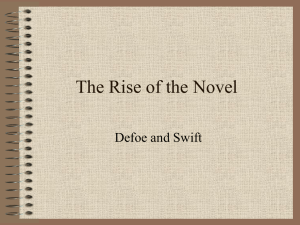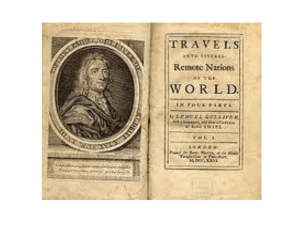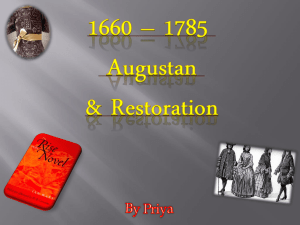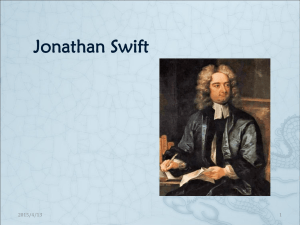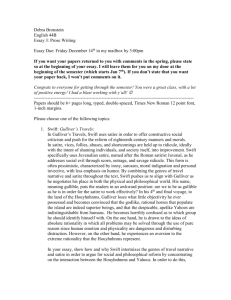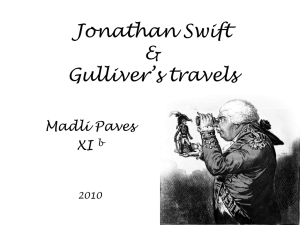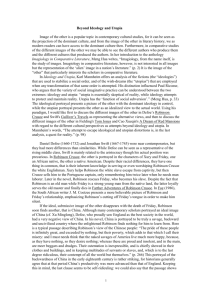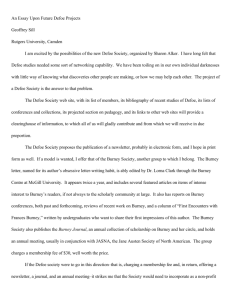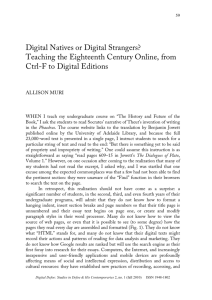18th Century Prose - A Brief Look At English Literature
advertisement
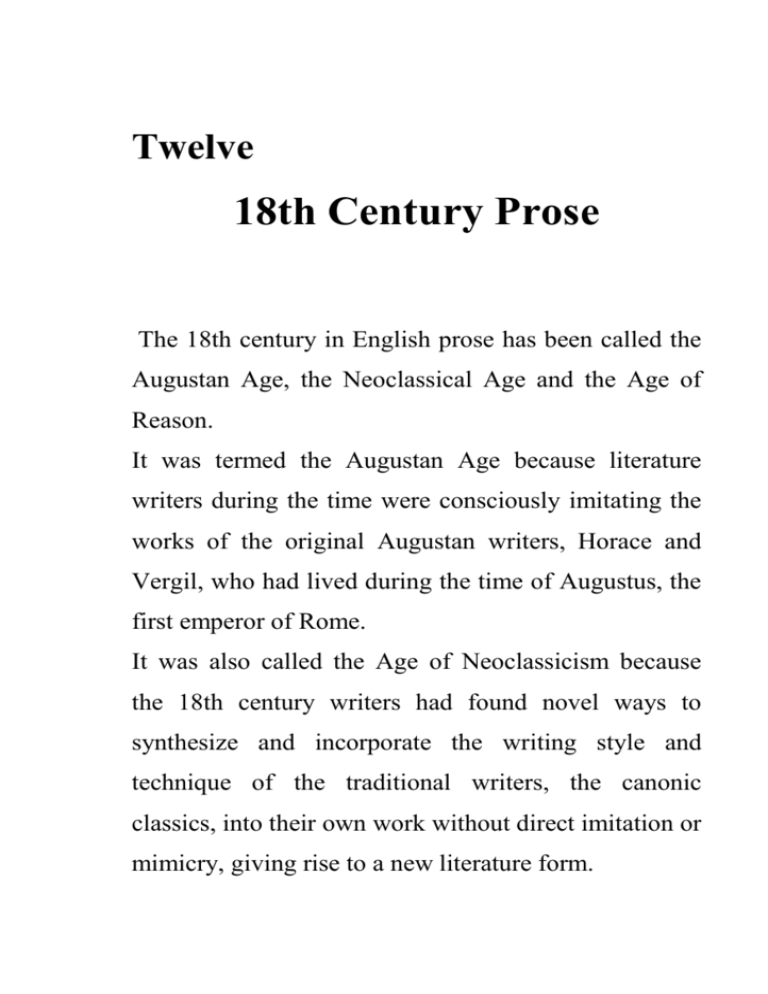
Twelve 18th Century Prose The 18th century in English prose has been called the Augustan Age, the Neoclassical Age and the Age of Reason. It was termed the Augustan Age because literature writers during the time were consciously imitating the works of the original Augustan writers, Horace and Vergil, who had lived during the time of Augustus, the first emperor of Rome. It was also called the Age of Neoclassicism because the 18th century writers had found novel ways to synthesize and incorporate the writing style and technique of the traditional writers, the canonic classics, into their own work without direct imitation or mimicry, giving rise to a new literature form. A Brief Look At English Literature Finally, the 18th century in English prose has also been called the Age of Enlightenment or the Age of Reason mainly because it focused on reason and rational thought as the primary basis of authority, a divergence from previously-held and widely-accepted notions in which God and nature were the pillars of authority. The 18th century in English literature was a kaleidoscope of emerging literary movements, forms and styles which had been received with much acclaim as well as criticism during the time. We will start of with a study of the literature of Alexander Pope and Jonathan Swift who used satire as the vehicle for social and political commentary and criticism. Then we take a closer look at the emergence of the realistic modern novel, pioneered by Daniel Defoe. After, we go through James Boswell’s great foray into biographic writing in which he offered a personal glimpse into the life of a literary genius. 2 A Brief Look At English Literature Finally, we will delve into Edward Gibbon’s historiography of the Roman Empire and its implications in the contemporary world. Satire: Alexander Pope and Jonathan Swift Satire was a common theme in 18th century English literature. Satirical literature is criticism of an individual, group, a social practice or the government that is hidden in comedy, wit, sarcasm and irony. The subject of a satirical piece is often exposed to subtly veiled ridicule that when finally recognized, would hopefully convince the satiric subject to change. The most accomplished writer of the Augustan Age was Alexander Pope. Equally proficient in poetry, prose as well as in the translations of the classics, he was called the “The Wicked Wasp of Twickenham” because of unabashed 3 A Brief Look At English Literature criticism of the writing styles of his literary contemporaries. Pope had to struggle against two disadvantages during his lifetime: he was crippled because of a deformity of the spine and he was also denied a university of education because he was a Roman Catholic living in largely Protestant England. In true Augustan form, Pope’s first published work in 1709 was an imitation of Vergil, entitled the Pastorals. He also imitated Horace’s Art of Poetry and published An Essay on Criticism in 1711 which produce the very famous line, “To err is human, to forgive, divine”. He also published The Rape of the Lock in 1712, a mock-heroic poem which introduced his famous heroic couplet. Pope’s most persevering work, however, was his translation of Homer’s Iliad in 1720 and Odyssey in 1726. 4 A Brief Look At English Literature These translations brought Pope significant financial success and he is often considered as the first writer in history to actually make a living out of writing. One of Alexander Pope’s literary contemporaries, Jonathan Swift, is best recognized for his satirical masterpiece, Gulliver’s Travels. In the tale, Captain Lemuel Gulliver travels to Lilliput where the inhabitants are diminutive in size such that Captain Gulliver is all but amused at their attempt at civilization. He then travels to Brobdingag where the opposite happens because its inhabitants are giants who laugh at Captain Gulliver’s miniscule size and his account of the greatness of England, Alexander Swift’s direct stab at England’s overpowering sense of superiority. Next, Captain Gulliver finds himself in Laputa and Lagado which were inhabited by scientists and quack doctors, written by Swift as a thinly veiled criticism of 5 A Brief Look At English Literature the scientists and writers of his time who were obsessed with immortality. Finally, Captain Gulliver travels to Houyhnhnmland where horses behaved like rational men and humans behaved like beasts, Swift’s satire of humans treading the thin line between humanity and bestiality. Although written as a political and social satire, the characters of Gulliver’s Travels had greatly appealed to children and in modern times, it is often considered as a bedtime story. However, during its three printings in 1726, it became an instant hit and was later translated to French, German and Dutch the following year. Swift also published A Modest Proposal for Preventing the Children of Poor People from Being a Burden to their Parents or Their Country in 1729 where he expressed his intense disdain for Britain’s exploitative economic policy in Ireland, his home country. 6 A Brief Look At English Literature In A Modest Proposal, Swift satirically suggests that the poor Irish must fatten their children like farm animals and sell them as a delicacies and treats for British gentlemen in order to correct Ireland’s economic imbalance. Novel: Daniel Defoe Considered by literary historians as a pioneer in the field of realistic fiction writing, Daniel Defoe was a novelist, journalist and political pamphleteer who produced more than 500 books, poems, articles and pamphlets. Defoe had turned to focus on writing when he became bankrupt in 1692 and his first important piece was An Essay Upon Projects released in 1698. But it was his popular poem support of the Dutch-born King William III, The True-Born Englishman, that brought him much fame. In The True-Blue Englishman, Defoe had stubbornly rebuked the English people for questioning the king’s 7 A Brief Look At English Literature lineage and discriminating against foreigners because according to Defoe, most of the things that they had considered typically English, were in fact of foreign nature and therefore they had no right in criticizing their king. It was not until he was almost 60 years old that Defoe turned to writing novels with Robinson Crusoe published in 1719 as his best-known realistic fiction novel. Robinson Crusoe was inspired by the tale of the Scottish sailor, Alexander Selkirk, who had been stranded in an island near Chile. Defoe’s strong narrative was spectacularly showcased in the novel’s seemingly realistic descriptive passages, which were centered on man’s amazing ability to endure and survive despite so many trials in an unforgiving environment. This theme of difficulties of surviving in a threatening world and man’s natural instinct for self-preservation is 8 A Brief Look At English Literature also manifested in Defoe’s later works, particularly The Fortunes and Misfortunes of the Famous Moll Flanders, A Journal of the Plague Year, The History and Remarkable Life of the Truly Honorable Colonel Jack, all published in 1722, and Roxana, published in 1724. Biography: James Boswell James Boswell once claimed that his biography of Samuel Johnson, The Life of Samuel Johnson, LL.D. (1791), was “the most perfect that can be conceived” and it was rightly so. This two-volume biography of the writer Samuel Johnson whom he first met in 1763 and with whom he had a lifelong correspondence and friendship has been widely considered as one of the greatest English biographies. Whereas early biographers had the general tendency to describe their subjects from historical detached 9 A Brief Look At English Literature viewpoint, Boswell had been intensely personal in writing about the life of Johnson including not only his genius and moral worth but also all his human errors. Boswell had included in the biography conversations he had had with Johnson, which he had written down in his journals at the time. This lent a very personal account into the life of Johnson and readers of the biography were given a complete glimpse of an amazing life instead of a dry, impersonal narrative. Historiography: Edward Gibbon Edward Gibbon was the foremost historian of the 18th century. The History of the Decline of the Roman Empire, published from 1776 to 1788, which narrated the Roman Empire from the 2nd century AD to the fall of Constantinople in 1453, had been hailed as one of the greatest and widely read works of history. 10 A Brief Look At English Literature Gibbon had supported The History of the Decline of the Roman Empire with more than 8300 references and his own extensive knowledge of the geography of the classical world. This contrasted greatly with the contemporary historical works at the time that were more philosophycentered and less historical data driven. According to the six-volume historical text, the fall of the Roman Empire had been due to the rise of Christianity, for which Gibbon had been criticized by many. He also deftly contrasted the weakened Roman Empire to the energy of its conquerors. Beyond his extensive historical narrative, Gibbon sought to explain how the fall of the Roman Empire greatly influenced the modern world in terms of religious authority and scholastic philosophy, which had been the pervading culture of the 18th century when the historical text was written. 11 A Brief Look At English Literature By doing so, his work does not only have historical value but a social one as well. While there are still so many literary movements and styles that emerged during the 18th century, it was satiric literature, realistic fiction, biography and historiography works that defined the era. Pope, Swift, Defoe, Boswell and Gibbon had set the bar high by producing significant works of literature during the 18th century that went on and influenced the 19th century writers that came after them. 12
